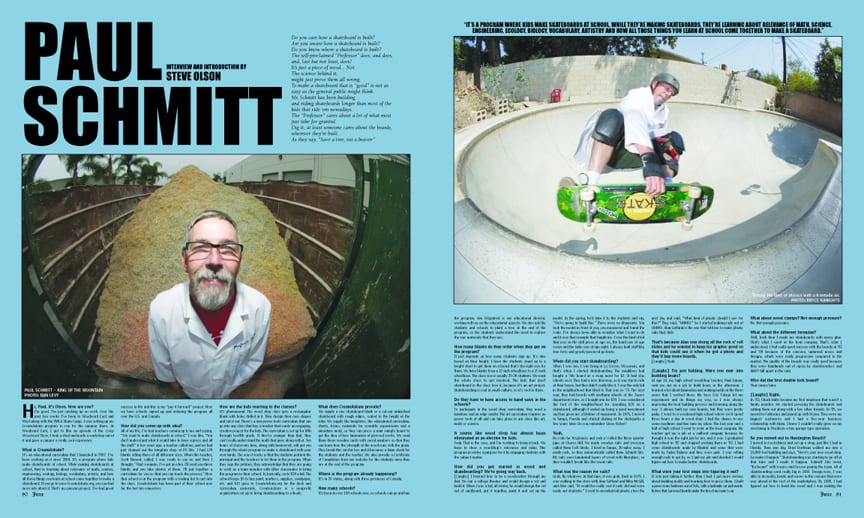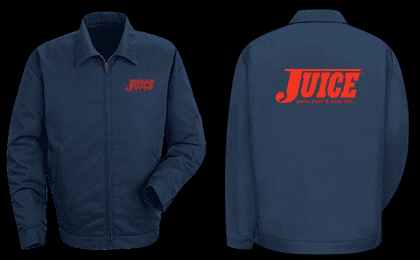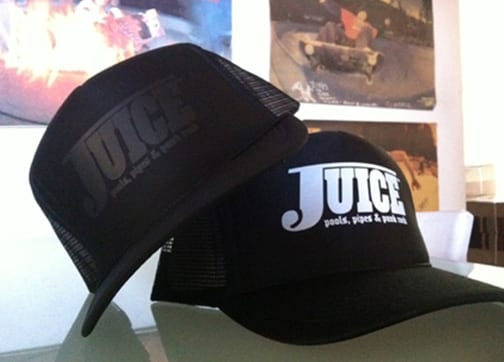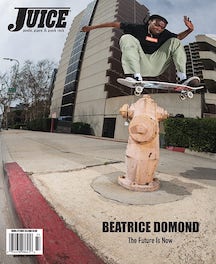INTERVIEW BY STEVE OLSON
INTRODUCTION BY STEVE OLSON
PHOTOGRAPHY BY DAN LEVY AND BRYCE KANIGHTS
Do you care how a skateboard is built? Are you aware how a skateboard is built? Do you know where a skateboard is built? The self-proclaimed ‘Professor” does, and does, and, last but not least, does! It’s just a piece of wood… Not. The science behind it, might just prove them all wrong. To make a skateboard that is ‘good” is not as easy as the general public might think. Mr, Schmitt has been building and riding skateboards longer than most of the kids that ride ’em nowadays. The ‘Professor” cares about a lot of what most just take for granted. Dig it, at least someone cares about the boards, wherever they’re built… As they say, ‘Save a tree, eat a beaver.’
“It’s a program where kids make skateboards at school. While they’re making skateboards, they’re learning about relevance of math, science, engineering, ecology, biology, vocabulary, artistry and how all those things you learn at school come together to make a skateboard.”
Hi, Paul. It’s Olson. How are you?
I’m good. I’m just catching up on work. Over the past two weeks I’ve been to Woodward East and West along with the YMCA Skate Camp. I was setting up my CreateAskate program to run for the summer there. At Woodward East, I got to film an episode of the Camp Woodward Show. I took a shed and made a workshop out of it and gave a camper a really cool experience.
What is CreateAskate?
It’s an educational curriculum that I launched in 2007. I’ve been working on it since 2004. It’s a program where kids make skateboards at school. While making skateboards at school, they’re learning about relevance of math, science, engineering, ecology, biology, vocabulary, artistry and how all those things you learn at school come together to make a skateboard. If you go to www.CreateAskate.org, you can find more info about it. That’s my passion project. I’ve had great success in life and this is my ‘pay it forward” project. Now we have schools signed up and ordering the program all over the U.S. and Canada.
How did you come up with idea?
All of my life, I’ve had teachers coming up to me and saying, ‘We want to make skateboards in school.” I was like, ‘You don’t understand what it would take to have a press and all the stuff.” A few years ago, a teacher called me, and we had just cleaned out the template shop at PS Stix. I had 170 blanks sitting there of all different sizes. When this teacher, Scott Diment, called, I was ready to say no and then I thought, ‘Wait a minute. I’ve got an idea. I’ll send you these blanks and you take photos of them. I’ll put together a curriculum for you so that you can teach the process.” Now that school is in the program with a waiting list to get into the class. CreateAskate has been part of their school now for the last ten semesters.
How are the kids reacting to the classes?
It’s phenomenal. The wood shop class gets a rectangular blank with holes drilled in it. They design their own shapes and cut it out. There’s a non-power tools curriculum that can go into any class that has a teacher that wants an engaging, creative project for the kids. The curriculum is set up for fifth through twelfth grade. If they’re younger than that, they can’t really understand the math that goes along with it. Ten hours of classroom time, along with homework, will get you through the whole program to make a skateboard with your own hands. The way it works is that the students petition the principal and the teachers to let them in the program. When they sign the petition, they acknowledge that they are going to work as a team member with other classmates to bring the program to their school. It, basically, costs $20 a kid. The school keeps $5 to buy paint, markers, supplies, sandpaper, etc. and $15 goes to CreateAskate.org for the deck and curriculum materials. CreateAskate is a nonprofit organization set up to bring skateboarding to schools.
What does CreateAskate provide?
We supply a raw skateboard blank or a cut-out unfinished skateboard with rough edges, scaled to the height of the rider. We supply the templates, the educational curriculum, charts, forms, materials for scientific experiments and a miniature mold, so they can press a mini sample board to get the idea of how lamination of plywood works. We send them these wooden cards with serial numbers so that they can learn how the strength of the wood runs with the grain. They break this card in two and it becomes a claim check for the students and the teacher. We also provide a Certificate of Completion from our website for the students once they are at the end of the program.
Where is the program already happening?
It’s in 20 states, along with three provinces of Canada.
How many schools?
It’s been in over 100 schools now, so schools can go and buy the program. Jim Fitzpatrick is our educational director, working with us on the educational aspects. We also ask the students and schools to plant a tree at the end of the program, so the students understand the need to replace the raw materials that they use.
How many blanks do they order when they get on the program?
It just depends on how many students sign up. It’s also based on their height. I have the students stand up to a height chart to get them on a board that’s the right size for them. We have blanks from a 12-inch wheelbase to a 15-inch wheelbase. The class size is usually 20-30 students. We want the whole class to get involved. The kids that don’t skateboard in the class love it, because it’s an art project. Skateboarding is cool in youth culture, so it’s cool to them.
Do they have to have access to band saws in the schools?
To participate in the wood shop curriculum, they need a bandsaw and an edge sander. The art curriculum requires no power tools at all and can take place in any class like art, math or science.
It seems like wood shop has almost been eliminated as an elective for kids.
Yeah. That is the case, and I’m working to bring it back. We hope to show a woodshop’s relevance and value. This program provides a purpose for it by engaging students with the subject matter.
How did you get started in wood and skateboarding? We’re going way back.
[Laughs] I learned how to be a woodworker through my dad. He ran a college theater and would design a set and build it. When I was a kid, all winter, he would design the set out of cardboard, put it together, paint it and set up the model. In the spring, he’d take it to the students and say, ‘We’re going to build this.” There were no blueprints. You took the model in front of you, you measured and found the scale. I’ve always been able to visualize what I want to do and it was that example that taught me. I was the kind of kid that was on the drill press at age six, the band saw at age seven and the table saw at age eight. I always built stuff like tree forts and gravity-powered go-karts.
When did you start skateboarding?
When I was ten, I was living in La Crosse, Wisconsin, and that’s when I started skateboarding. The neighbors had bought a ’60s board at a swap meet for $2. It had clay wheels on it. They had a new driveway, so it was fun to ride at their house, but they didn’t really like it. I was the only kid in the neighborhood that liked it. That was in ’73. The next year, they had boards with urethane wheels at the Zayers department store, so I bought one for $20. I was considered the fool of the neighborhood for spending $20 on a skateboard, although it ended up being a good investment and has given me a lifetime of enjoyment. In 1975, I moved to Tampa, Florida and started skating at the skateparks a few years later. Do you remember Steve Fisher?
Yeah.
He rode for Kryptonics and rock n’ rolled the three quarter pipe at Cherry Hill. He made wooden rails and everyone called them Fish Sticks. I lived in Tampa, 30 miles away. I made rails, so they automatically called them Schmitt Stix. My rails were laminated layers of wood with fiberglass, so they wouldn’t break like the wood rails.
What was the reason for rails?
Grab, fly, whatever. At that time, it was grab. Back in 1979, I was walking to the store with Alan Gelfand and Mike McGill, and Alan said, ‘It would be really cool if rails slid and were made out of plastic.” I went to an industrial plastic store the next day and said, ‘What kind of plastic should I use for this?” They said, ‘UHMW.” So I started making rails out of UHMW. Alan Gelfand is the one that told me to make plastic rails that slide.
That’s because Alan was doing all the rock n’ roll slides and he wanted to keep his graphic good so that kids could see it when he got a photo and they’d buy more boards.
[Laughs] Yeah.
[Laughs] I’m just kidding. Were you ever into building boats?
At age 16, my high school woodshop teacher, Paul Gmuer, sent me out on a job to build boats in the afternoon. I learned a lot about lamination and making molds in the three years that I worked there. My boss Eric Falago let me experiment and do things my way, so I was always improving the boat building process and learning along the way. I always built my own boards, but they were pretty junky. I went to a vocational high school where we’d spend three hours a day in wood shop. I had the chance to use some machines and fine tune my ideas. The last year and a half of high school I went to work at the boat company. My teacher got me a job at a sailboat company because he thought it was the right job for me, and it was. I graduated high school in ’82 and stopped working there in ’83. I had some skateboards made by Madrid and some that were made by Taylor/Dykma and they were junk. I was selling enough rails to get by, so I quit my job and decided I would figure out how to make better skateboards.
What were your first steps into figuring it out?
It was just taking it further than I had. I got more serious about building molds and learning how to press them. I built a press in my bedroom out of 2x6s, with a hydraulic car jack inside. Before that I pressed boards under the tire of my mom’s car.
What about wood clamps? Not enough pressure?
No. Not enough pressure.
What about the different formulas?
Well, back then I made my skateboards with epoxy glue. That’s what I used at the boat company. That’s what I understood. I had really good success with the boards in ’83 and ’84 because of the concave, upturned noses and designs, which were really progressive compared to the market. The quality of the boards was really good because they were handmade out of epoxy by skateboarders and didn’t fall apart in the rain.
Who did the first double kick board?
That comes later.
[Laughs] Right.
In ’83, Chuck Hults became my first employee that wasn’t a family member. He started pressing the skateboards and cutting them out along with a few other friends. In ’85, we moved to California and joined up with Vision. They were my biggest customers and I had a five-year business relationship with them. I knew I couldn’t really grow on my own being in Florida in a tiny garage type operation.
So you moved out to Huntington Beach?
I moved to Costa Mesa and set up a shop, just like I had in Florida. Then one day, Brad Dorfman walked me into a 15,000-foot building and says, ‘Here’s your new wood shop. Go make it happen.” Skateboarding was starting to go off at that time and I made it happen. Schmitt Stix went, ‘Ka-boom!” with Lucero and Grosso joining the team. All of skateboarding went really big in 1986. Design-wise, I was able to do molds, bends and curves in the concave that were way ahead of the rest of the marketplace. By 1988, I had figured out how to bend the wood and I was making the nose longer and as steep as the kicktail with a concave that was parallel and not tapered from front to back. The first time we did that was the skateboard with the dog on it. People at the trade show were freaked out because it had a funny shape, and it had a nose that stuck up in the air. Chris Miller didn’t ride for G&S anymore. They were all freaked out at that tradeshow. There were doubters and believers. By the next tradeshow, everyone was following the trend, and modern street skating needed the longer, steeper nose to ollie with more control and it progressed from there.
Really? So you’re saying that you guys brought in the double kick?
Well, the truth is the first board that was a true double kick, with a nose as long as the tail, was made by Chuck Hults for Vision in 1990. Chuck Hults gets the credit for that.
FOR THE REST OF THE STORY, ORDER ISSUE #66 BY CLICKING HERE…
SHARE THIS POST:
- Click to email a link to a friend (Opens in new window)
- Click to share on Tumblr (Opens in new window)
- Click to share on LinkedIn (Opens in new window)
- Click to share on Pinterest (Opens in new window)
- Click to share on Twitter (Opens in new window)
- Click to share on Facebook (Opens in new window)
- Click to share on Reddit (Opens in new window)
- Click to print (Opens in new window)












One Response
Would like to know who built your pool.